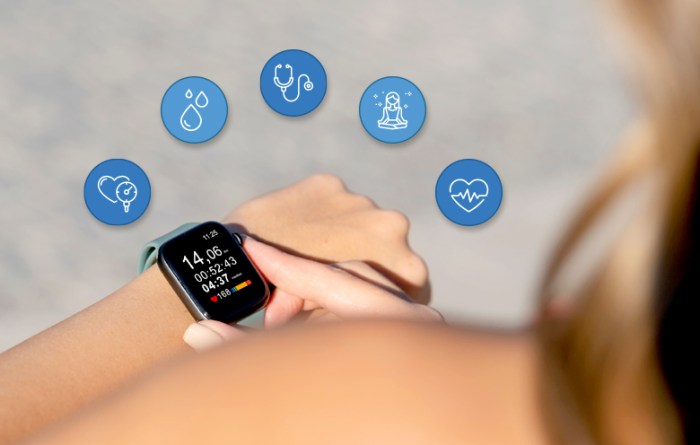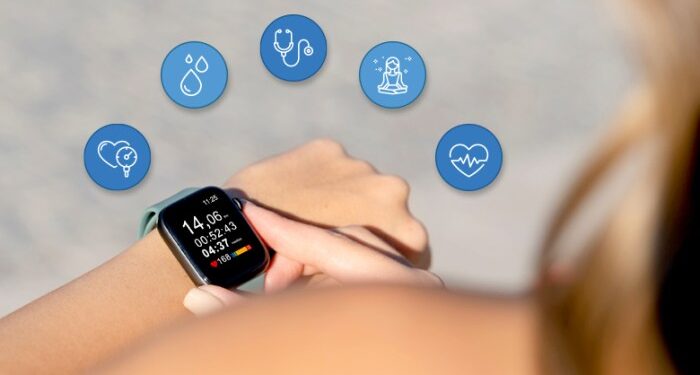Starting off with Smartwatch features for tracking your health, this introduction aims to provide an intriguing overview of how these devices can revolutionize health monitoring.
Exploring the various sensors, fitness tracking capabilities, health monitoring features, and app integrations, smartwatches offer a comprehensive approach to tracking and improving one's health.
Smartwatch Sensors
Smartwatches come equipped with various sensors that play a crucial role in tracking your health and fitness levels. These sensors work together to provide accurate data on different aspects of your well-being.
Heart Rate Sensors vs. ECG Sensors
Heart rate sensors in smartwatches use photoplethysmography (PPG) technology to monitor your heart rate by measuring blood flow through your wrist. While these sensors are convenient and provide real-time heart rate data, they may not always be as accurate as medical-grade ECG (electrocardiogram) sensors.
ECG sensors offer more precise measurements by recording the electrical activity of your heart, providing detailed insights into your heart rhythm and detecting abnormalities.
Accelerometer and Gyroscope Sensors
Accelerometer sensors detect movement and orientation, measuring acceleration forces like speed, direction, and rotation. On the other hand, gyroscope sensors enhance the accuracy of motion tracking by measuring angular velocity and orientation changes. When combined, accelerometer and gyroscope sensors work harmoniously to track physical activities like steps taken, distance traveled, and different types of exercises.
These sensors enable smartwatches to provide accurate data on your daily activities and help you stay active and healthy.
Fitness Tracking Features
Smartwatches offer a variety of fitness tracking features to help users monitor their physical activity and health goals. These features are designed to provide valuable insights and motivation for users to stay active and healthy.
GPS Integration for Accurate Distance Tracking
GPS integration in smartwatches is crucial for accurate distance tracking during outdoor activities such as running, cycling, or hiking. By leveraging GPS technology, smartwatches can accurately calculate the distance traveled, pace, and route taken by the user. This real-time data not only helps users track their progress but also ensures precise measurements for setting fitness goals and improving performance.
Personalized Insights through Fitness Data Analysis
Smartwatches analyze fitness data collected throughout the day, including steps taken, heart rate, calories burned, and sleep patterns, to provide personalized insights. By analyzing this data, smartwatches can offer tailored recommendations for achieving fitness goals, such as suggesting workout intensities, rest periods, and activity levels.
This personalized approach helps users make informed decisions about their health and well-being based on their individual needs and preferences.
Health Monitoring Capabilities
Smartwatches offer a range of health monitoring capabilities that go beyond just tracking your steps and heart rate. Let's delve into how these devices can provide valuable insights into your overall well-being.
Sleep Pattern Monitoring
Smartwatches equipped with advanced sensors can monitor your sleep patterns throughout the night. By tracking your sleep stages, including deep, light, and REM sleep, these devices can provide you with a comprehensive analysis of your sleep quality. Understanding your sleep patterns can help you identify any disruptions or issues that may be affecting your rest, allowing you to make necessary adjustments for better sleep hygiene and overall health.
Stress Level Tracking
In addition to monitoring physical activity, smartwatches can also track your stress levels throughout the day. By analyzing factors like heart rate variability and skin temperature, these devices can provide insights into your stress levels and patterns. This data can help you identify triggers for stress and learn effective stress management techniques, such as mindfulness or relaxation exercises.
Blood Oxygen Saturation Monitoring
Some smartwatches are equipped with sensors that can measure blood oxygen saturation levels, also known as SpO2. Monitoring your SpO2 levels can provide valuable information about your respiratory and circulatory health. Low blood oxygen saturation levels can indicate potential issues like sleep apnea or respiratory conditions, prompting you to seek medical attention.
By regularly tracking your SpO2 levels, you can proactively monitor your overall health and well-being
App Integration

Integration of health and fitness apps with smartwatches has revolutionized the way we track our well-being. By connecting these apps to your smartwatch, you can access a plethora of features and data that can help you achieve your health goals more effectively.
Popular Health and Fitness Apps for Smartwatches
- Fitbit: Fitbit offers a range of health and fitness tracking features, including activity tracking, heart rate monitoring, sleep analysis, and more. It can be seamlessly integrated with various smartwatches to provide a comprehensive health tracking experience.
- Apple Health: Apple Health is a native app on Apple Watches that tracks various health metrics such as steps taken, calories burned, heart rate, and more. It can also be integrated with other third-party health apps to consolidate all your health data in one place.
- Google Fit: Google Fit is another popular health and fitness app that can be integrated with smartwatches running on Wear OS. It offers activity tracking, heart rate monitoring, and personalized coaching to help you stay fit and healthy.
Comparison of Native Health Tracking Apps
| Smartwatch Brand | Native Health Tracking App | Features |
|---|---|---|
| Apple | Apple Health | Tracks steps, calories, heart rate, sleep, and more. Offers a holistic view of your health data. |
| Samsung | Samsung Health | Tracks activity, heart rate, sleep, stress levels, and more. Provides personalized insights and challenges. |
| Fitbit | Fitbit App | Tracks activity, heart rate, sleep, nutrition, and more. Offers goal setting and community support. |
Benefits of Third-Party Health App Integration
- Access to a wider range of features and data beyond what native apps offer.
- Ability to customize your health tracking experience based on your specific needs and preferences.
- Integration with popular health and fitness apps allows for seamless data syncing and analysis across platforms.
- Enhanced motivation and engagement through challenges, competitions, and community support offered by third-party apps.
Ending Remarks
Concluding our discussion on Smartwatch features for tracking your health, it's evident that these wearable devices play a crucial role in promoting a healthier lifestyle through advanced tracking and personalized insights.
Question Bank
How accurate are heart rate sensors compared to ECG sensors in smartwatches?
Heart rate sensors in smartwatches provide a general estimate, while ECG sensors offer more precise readings by measuring electrical activity of the heart.
What are the benefits of tracking sleep patterns with smartwatches?
Tracking sleep patterns helps in understanding sleep quality, identifying sleep disturbances, and improving overall sleep habits for better health.
Why is GPS integration important for accurate distance tracking during outdoor activities?
GPS integration ensures precise distance tracking by utilizing satellite data, improving the reliability of fitness data during outdoor workouts.
What are some popular health and fitness apps that can be integrated with smartwatches?
Popular apps like Fitbit, MyFitnessPal, and Strava can be seamlessly integrated with smartwatches to enhance health tracking and analysis.














